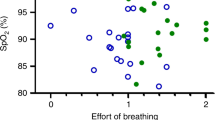Abstract
Objective
The main objective of this study was to describe frequency of risk factors in newborns who present different types of apnea in polysomnographic (PSG) recordings in neonatal care units.
Methods
The study was carried out in neonatal care units of a perinatal tertiary level institution in Mexico City between August 2002 and August 2003. Infants were selected from among 223 infants if they presented any type of apnea event in sleep PSG recordings.
Results
Nearly 25% of patients from a neonatal care unit presented apnea events. Infants with apnea showed lower values of age, weight, and cephalic perimeter at birth than infants without apnea, but did not show more neurologic risk factors. Central apnea events were more frequent in infants with preterm birth (birthweight <1,500 g), obstructive apnea events were observed in infants with hyperbilirubinemia and gastro-esophageal reflux, while mixed events were seen in infants with sepsis, and hyperbilirubinemia. Sleep PSG recordings detected that 36% of infants with apnea have no previous clinic suspicion of the problem.
Conclusion
Central events of apnea were found more frequent in infants with preterm birth, obstructive events in newborns with hyperbilirubinemia and gastroesophagic reflux, while infants mixed apnea had more frequent hyperbilirubinemai and sepsis.
Similar content being viewed by others
References
Task Force on Prolonged Apnea. Prolonged apnea.Pediatrics 1978; 61: 651–652.
Baird TM. Clinical correlates, natural history and outcome of neonatal apnoea.Semin Neonatol 2004;9:205–211.
Finer NN, Barrington KJ, Hayes BJ, Hugh A. Obstructive, mixed, and central apnea in the neonate: Physiologic correlates.J Pediatr 1992;121:943–950.
Hofmann E, Havens B, Geidel S, Hoppenbrouwers T, Hodgman TE. Long-term, continuous monitoring of multiple physiological parameters in newborn and young infants.Acta Paediatr Scand 1977;suppl 266:1–24.
Prechtl HFR. The behavioral states of the newborn (a review).Brain Res 1974;76:185–212.
Stockard-Pope JE, Werner JE, Bickford RG.Atlas of neonatal electroencephalography. New York, Raven Press. 1992
Cursi-Dascalova L, Mirmiran M.Manuel des techniques d’enregistrement et d’analyse des stades de sommeil et de veille chez le prématuré et le nouveau-né a terme. Paris; Editions INSERM. 1996
Hoppenbrouwers T, Hodgman JE, Harper RM, Hofmann E, Sterman MB, McGinty DJ. Polygraphic studies of normal infants during the first six months of life: III. Incidence of apnea and periodic breathing.Pediatrics 1977;60:418–425.
Kato I, Franco P, Groswasser J, Kelmanson I, Togari H, Kahn A. Frequency of obstructive and mixed sleep apneas in 1,023 infants.Sleep 2000;23:487–492.
Deykin E, Bauman ML, Kelly DH, Hsieh CC, Shannon D. Apnea of infancy and subsequent neurologic, cognitive, and behavioral status.Pediatrics 1984;73:638–645.
Poblano A. Neurophysiological studies in early detection of neurological damage (in Spanish). In: Poblano A (ed.).Early detection and intervention in infants with neurological damage. México, Editores de Textos Mexicanos. 2003;101–129.
Denavi-Saubié M, Kalia M, Pierrefiche O, Schweitzer P, Foultz AS, Champagnat J. Maturation of brain stem neurons involved in respiratory rhythmogenesis: biochemical, bioelectric and morphological properties.Biol Neonate 1994;65:171–175.
Scheidt PC, Bryla DA, Nelson KB, Hirtz DG, Hoffman HJ. Phototherapy for neonatal hyperbilirubinemia: Six-year follow-up of the national Institute of Child Health and Human Development.Pediatrics 1990;85:455–463.
Menon AP, Schefft GL, Thach BT. Apnea associated with regurgitation in infants.J Pediatr 1985;106:625–629.
Ruggins NR, Milner AD. Site of upper airway obstruction in preterm infants with problematic apnoea.Arch Dis Child 1991; 66:787–792.
Meade RH. Bacterial meningitis in the neonatal infant.Med Clin North Am 1985;69:257–267.
Scanlon JEM, Chin KC, Morgan MEI, Durbin GM, Hale KA, Brown SS. Caffeine or theophylline for neonatal apnoea.Arch Dis Child 1992;67:425–428.
Gerhardt T, McCarthy J, Bancalari E. Effects of aminophylline on respiratory center and reflex activity in premature infants with apnea.Pediatr Res 1983;17:188–191.
Poets CF, Stebbens VA, Samuels MP, Southall DP. The relationship between bradychardia, apnea, and hypoxemia in preterm infants.Pediatr Res 1993;34:144–147.
Alvarez JE, Bodani J, Fajardo CA, Kwiakowski K, Cates DB, Rigatto H. Sighs and their relationship to apnea in the newborn infant.Biol Neonate 1993;63:139–146.
Author information
Authors and Affiliations
Corresponding author
Rights and permissions
About this article
Cite this article
Poblano, A., Márquez, A. & Hernández, G. Apnea in infants. Indian J Pediatr 73, 1085–1088 (2006). https://doi.org/10.1007/BF02763050
Issue Date:
DOI: https://doi.org/10.1007/BF02763050




